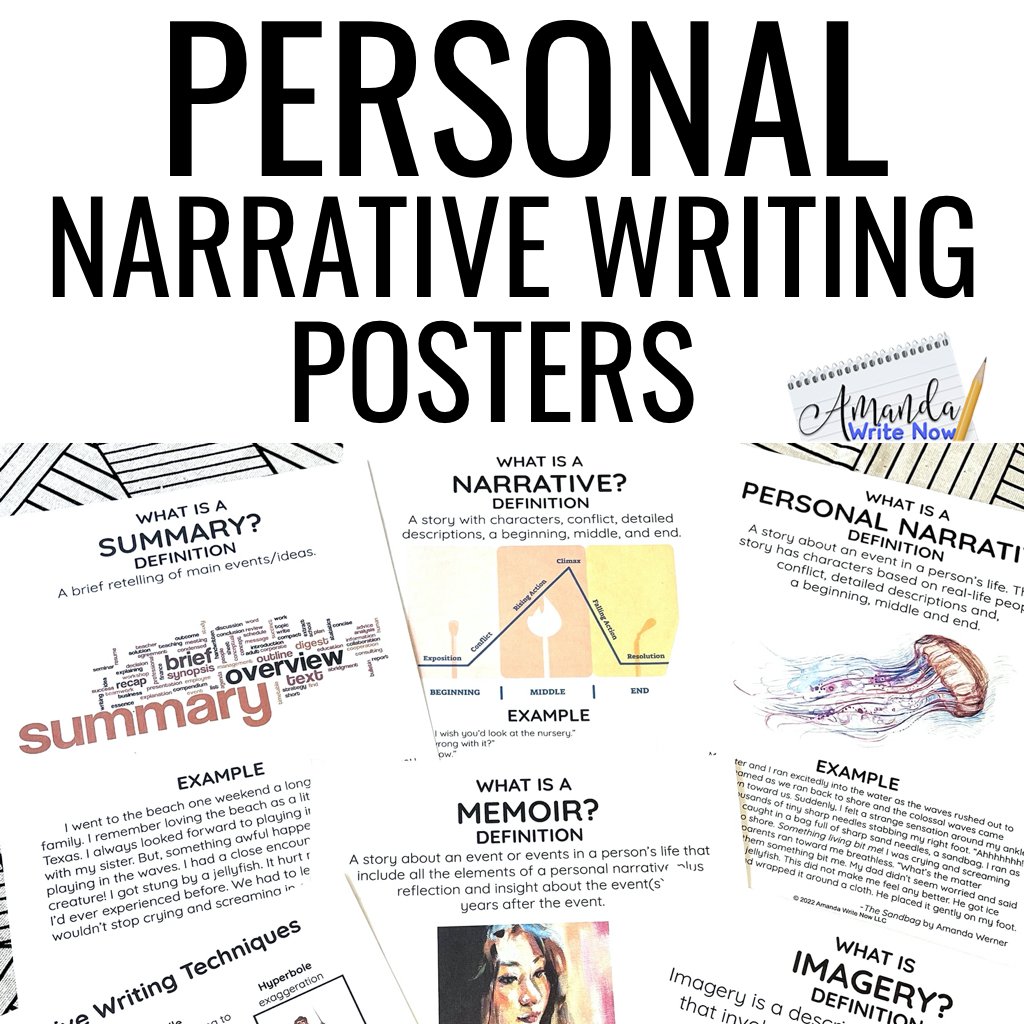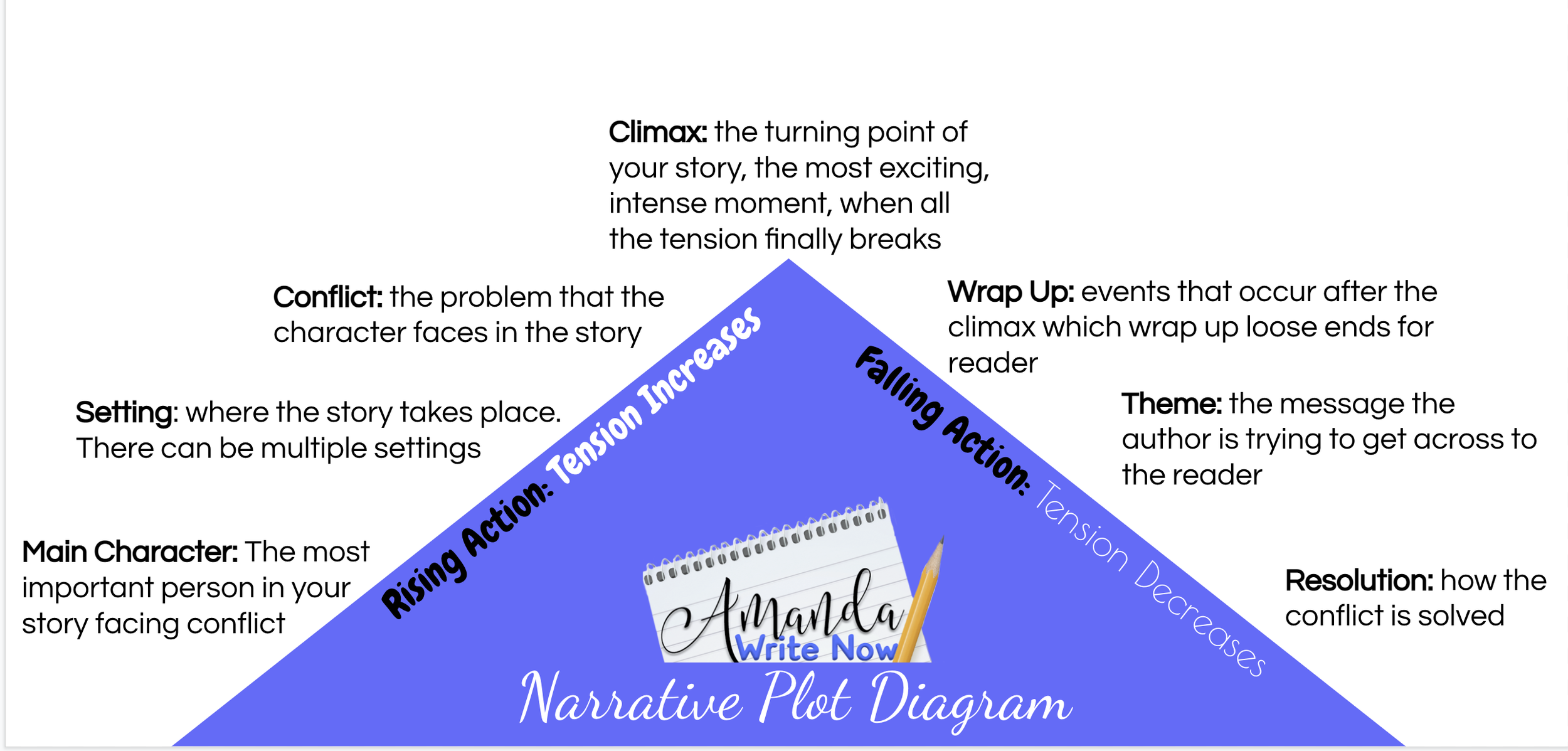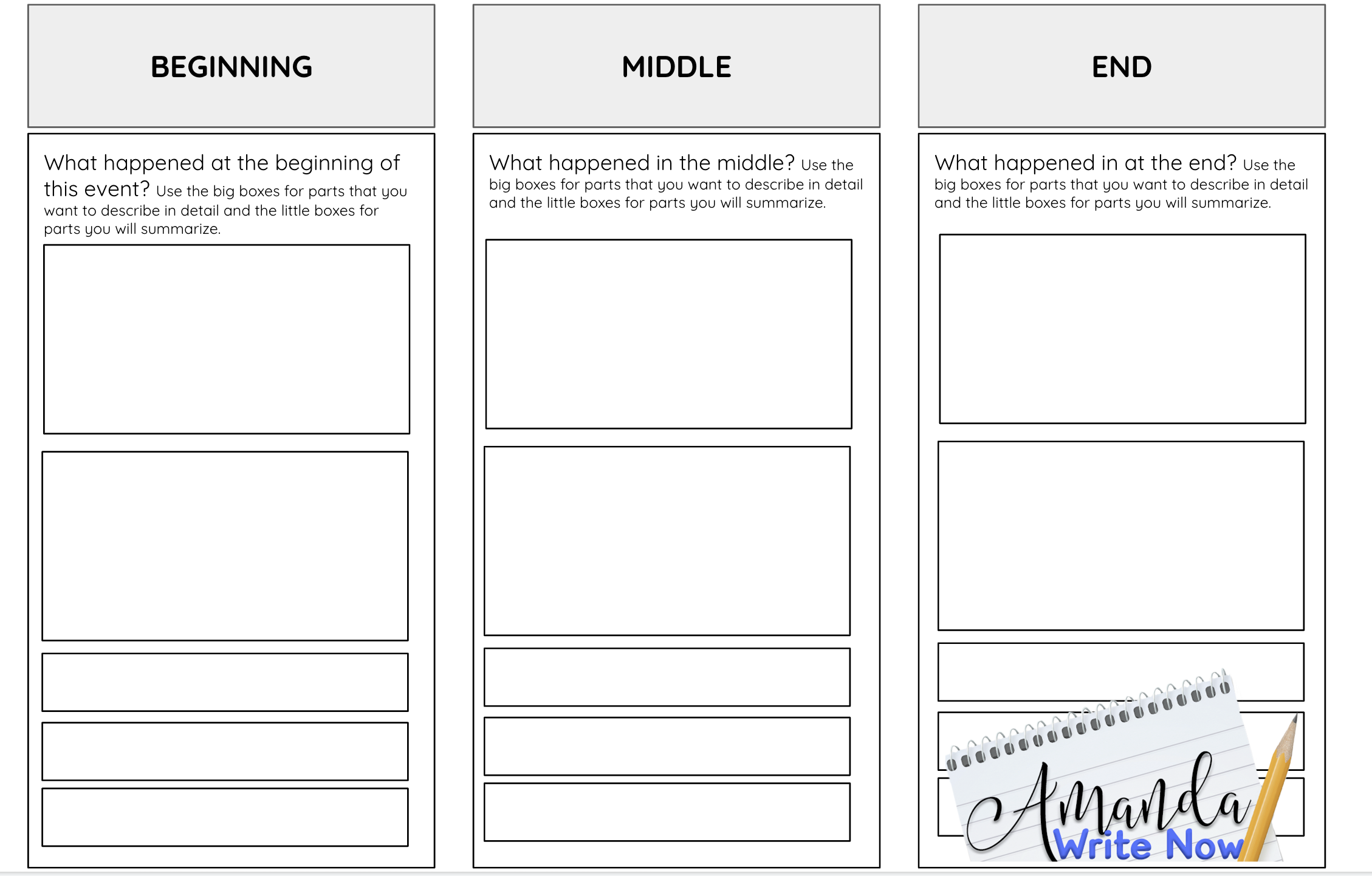5 Essential Scaffolds for Personal Narrative Writing
Do you begin your school year with personal narrative writing? Most elementary and middle schools in the United States begin their school year with this type of writing, often to a chorus of moans and groans. Students shout out, “But, we already learned this!” or “We did that last year!” or “Do we have to?”. This can cause a feeling of immediate defeat and that is no way to start a year. Teaching personal narrative writing doesn’t have to be so challenging. In this blog post, you’ll learn five important yet simple ways to scaffold personal narrative writing and get students excited to write too!
1. Key Terms
First of all, we must explicitly teach the following key terms and display these terms with visual representations in our classrooms for all students to see and refer to throughout the unit. The resource pictured below includes 10 colorful 8.5 x 11-inch PDF posters. Check out the personal narrative posters resource below by clicking here.
Summary: A summary is not a narrative. Sometimes we are tempted to just summarize an event when we write a story. That is not the point of a narrative! A story draws the reader in, making them want to read more! Some of your narratives will have to have a bit of summary of course. But, most narratives include lots of descriptions.
Narrative: A story with characters, conflict, and vivid/detailed descriptions.
Personal Narrative: A story about an event in a person’s life. This story has characters based on real-life people, conflict, and vivid/detailed descriptions.
Memoir: A story about an event or events in a person’s life that includes all the elements of a personal narrative plus reflection and insight about the event(s).
2. OrganizationAL Frameworks
Once key terms are explicitly taught and students comprehend the nuances of personal narrative writing, you can provide students with a variety of frameworks or outlines to get them started. I would introduce these frameworks after students have spent some time brainstorming important events they might want to write about. Below are some possible organizational frameworks you could provide students with. It’s important to tell students they don’t have to use every part of the organizational frameworks though. Explain that they can utilize some parts that help them get ideas for how to tell their story, and leave the rest.
Traditional Plot- most narratives we read utilize this framework. They begin by introducing the characters, then a conflict occurs, the action rises and falls, and finally, the resolution wraps up the story. Students who use this framework may be tempted to summarize each component. Make sure to emphasize that most parts of this framework have detailed and meaningful descriptions. Some summary is okay but it’s important to explain to students that they should never summarize everything. Warn students that summarizing too much leads to boring writing. Emphasize to students that their job as writers is to bring pictures into the reader’s mind and captivate readers so they will want to read more!
Chronological- this framework is organized by focusing on what happened in the beginning, middle and end. This is a really simple framework that can help struggling writers get some ideas down. Students who use this framework might be tempted to just summarize each event too though. So make sure you ensure students understand which event they will describe in vivid detail (zoom in on) and which events may be summarized. It could be very helpful to create large text boxes of scenes that will be detailed and small boxes for scenes that will be summarized.
Hero’s Journey- this framework has been popularized by Joseph Cambell, Star Wars movies, Percy Jackson, and Harry Potter books. This framework is organized into eleven parts: the character is living their normal/status quo life, then there is something that happens that calls them to adventure, there is some sort of big problem or crisis, and there is a guide who is introduced that helps the character in some way through this crisis, then there is a return to the status quo but with a character that has changed somehow.
Teachers may assume this organizational framework is only for fictional stories, but that’s not true. Parts of this framework can be used for personal narrative writing too. For example, you might explain to students that their personal narrative can start off kind of boring…describing normal life, the status quo. Then, one day some problem occurs or a mistake happens that requires some sort of ordeal or even adventure. Not all aspects of the framework need to be utilized, just the parts that spur student ideas.
3. Descriptive Writing Exercises
Students need lots of opportunities to practice their creative and descriptive writing skills. This is probably one of the most challenging parts of narrative writing, for kids and adults. This is why we need exercises that will get our creative and descriptive juices flowing. This blog post about how to teach descriptive writing can help. Below are a few exercises you can try with your students to get them to write with more detail.
Character Descriptions: Don’t remember? Make it up.
Explain to students that no one ever really remembers all the details of past events, so you have to make a lot of it up! Here’s an example describing my 3rd-grade teacher. I made a lot of the details up based on the blurry memory that the teacher had black hair and dressed nicely. That’s all I remembered! Ms. Perez stood at the front of the room and announced, “Today is an exciting day, you get to find out what reading group you are in!”. Her hands were crossed in front of her black and white polka-dot dress and her eyeglasses covered most of her face. She had short jet black hair, bright red lipstick, and black eyeliner. She seemed mean. But, I came to know her as a kind and patient teacher. She smiled often and spoke softly. For this exercise, have students make some of the details about the characters in their story up, to add to the story and help readers see the events of the story more clearly.
Verbs Speak Louder Than Adjectives.
Often, students think they need to add more adjectives to write more descriptively, but that’s a mistake! What students need are more action verbs. Show students an example of a sentence with too many adjectives and then the same sentence using verbs. Here’s an example: Ms. Nina was mean, cruel, and horrible versus Ms. Nina swiped the paper from my desk and announced to the entire class that my work was too messy. For this exercise, analyze the difference between the two sentences with students and then have them try it out on a sentence from their first draft. Tell students to have characters doing something to show what they want to describe rather than using describing words.
To Summarize or Describe, That is the Question
This exercise helps students understand that they need to alternate between summary and detailed descriptive writing when writing their personal narratives. They shouldn’t just summarize everything and they shouldn’t describe every detail either. Here are examples of too much summarizing and another example of repetitive descriptive details. The final example alternates between summary and description.
Summary: I hated going to that “special” classroom. It was embarrassing and I was treated like I didn’t know anything. I was forced to sit in the same chair every day that year.
Description: The tiny, “special” classroom was dark, dusty, and smelly. I was embarrassed, scared, and bullied by the teacher every day. She made me sit in a dirty, old, orange chair.
Alternating: I hated going to that tiny “special” classroom every day. It was always so dark and smelled like years-old dust. I looked around with embarrassment as the teacher pointed to the old, orange chair that would be mine for the rest of the school year.
After discussing the three sentences have students pull a sentence from their story to try out the alternating between summary and description technique.
4. WOrd Banks
Students need to be surrounded by interesting words and phrases they can experiment with. This can be a huge support for students who struggle to write personal narratives. Here are some word bank topic ideas:
Said is Dead-post synonyms for said instead! This will not only give students access to better, more descriptive vocabulary for said, it will also get them paying more attention to repetitive writing.
Transitions Words-post different transition words and phrases to help students with organization. Urge students to experiment with new transition words in their personal narratives.
The Meaning of Colors-post colors and their meanings to remind students that the color red could signify anger and blue might signify sadness.
Action Phrases to Replace Adjectives-instead of a word bank of adjectives, post a word bank that has an adjective and then verbal phrases underneath that might show the word more clearly for readers. For example, the word sad might have phrases like head down, tears streaming, eyes closed, heart pounding.
5. Sentence Stems
Sometimes students need a lot more support than we realize. These students are often “print resistant”, meaning that writing does not come easy to them for a multitude of reasons. These students are often much more tactile and love to build. We can help them by providing cut-out sentence stems they can manipulate to build their story. Below are a few sentence stems you might give to students to fill out and manipulate:
Stems for Starting or Ending a Personal Narrative
Everything changed the day…
The scariest moment of my life happened when…
The most important moment of my life happened when…
Sentence Stems for Describing a Character
[Name of character] is known for…
[Name of character] knew how to...
[Name of character] made me…
Sentence Stems for Describing a Setting
I looked around and saw…
This place was special because…
[Name of Setting] was where we went to…
Wrap Up
We can’t just give students a mentor text and a rubric and expect them all to write a personal narrative successfully. Yes, some students are skilled at this type of writing, but others need scaffolding. These scaffolds may work for some students and not for others. It’s important to experiment, test and pivot based on the needs of our students. A final, powerful scaffold is having a discussion with the student, asking them what they think might help. Students are often quite insightful when given the chance.
Related Resources
Personal Narrative Writing Posters
Personal Narrative Writing Unit
Related Blog Posts
How to Teach Descriptive Writing
About the Author
Amanda Werner has been teaching for 14 years and still feels like a novice. Every year is a unique and exciting challenge to inspire a new group of students to become avid readers and writers. Amanda reads educational literature voraciously and writes about the teaching of reading and writing on her website amandawritenow.com. Amanda received her B.A. in English Literature with an emphasis in Humanities at Western Washington University. In her free time, Amanda loves being outdoors with her husband and daughter.





